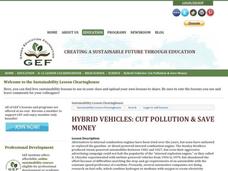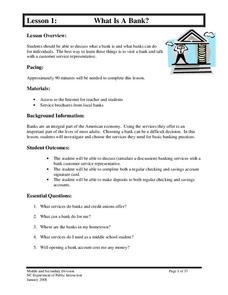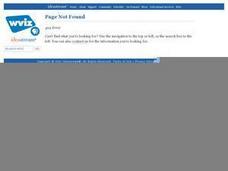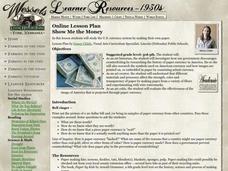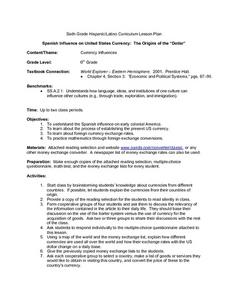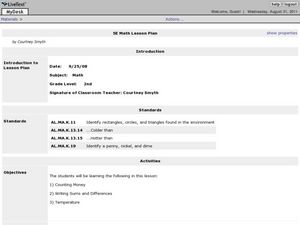101 Questions
Money Duck
A video presentation shows duck-shaped soap that has a $1, $5, $10, $20, or $50 bill in its center. Learners consider different population distribution of the bills to determine a reasonable price for the duck.
Curated OER
Hybrid Vehicles: Cut Pollution and Save Money
Math and science meet in this lesson on hybrid electric automobiles. This 24-page resource provides everything you need for teaching a lesson that compares the use of internal combustion engines to hybrid electric engines. Participants...
Wells Fargo
Hands on Banking
Cha-ching! You just hit the jackpot with this interactive consumer math unit. Supported by a series of online lessons and activities, these lessons engage students in applying their math skills to real-life personal finance problems...
North Carolina Department of Public Instruction
What Is A Bank?
You're never too young to learn about banking and personal finance. Use a set of seven banking lessons to teach middle schoolers about checking and savings accounts, interest rates, loans and credit cards, and safety deposit boxes.
Federal Reserve Bank
Banking on Debit Cards
What are the advantages and disadvantages of using a credit card versus a debit card? What are the costs of using a debit card irresponsibly? Here you'll find a lesson on key concepts that every learner should know regarding personal...
Conneticut Department of Education
Personal Finance Project Resource Book
Balancing a budget, paying taxes, and buying a home may feel out of reach for your high schoolers, but in their adult years they will thank you for the early tips. A set of five lessons integrates applicable money math activities with...
Radford University
Budgeting Your Time and Money
Use mathematics to better manage money. Pupils learn about budgets and personal finance with a set of three lessons. They research salary data for their chosen careers, look up various costs of living to develop budgets, and plan an...
Curated OER
Deciphering Word Problems in Order to Write Equations
Help young mathematicians crack the code of word problems with this three-lesson series on problem solving. Walking students step-by-step through the process of identifying key information, creating algebraic equations, and finally...
Howard Hughes Medical Institute
Lesson 2: Gorongosa National Park
How has Gorongosa National Park changed over time? Discover the park's rich history, dating back to primitive human times, through an interactive timeline and scientific reading. The second installment in an eight-part series explores...
Curated OER
Counting on Coins
Learners count coins. In this currency and mathematics lesson, students use skip counting to figure the value of a group of coins. Learners use plastic replica coins and real coins.
Curated OER
Give Me the Money
Students view a money transaction on video and identify the steps involved in making a purchase and calculating change. They write out original money math problems and exchange them with classmates.
Curated OER
Understanding the Effects of Currency Exchange Rates
In this algebra worksheet, students match the currency with the country of origin. They convert between that currency and the US using a foreign exchange conversion table. There are 35 questions.
Curated OER
My Money
Learners identify and interpret the relationships between various components of currency, discusses the uses of money, and provides advanced lessons on making change. They also identify the various ways that money is used and how to use...
Curated OER
Show Me the Money
Students investigate the history of paper currency in the United States and consider anti-counterfeit strategies that are used by making their own paper.
Curated OER
Money
Third graders review the values of quarters, dimes, nickels, and pennies. They discuss how the different types of coins can equal the same amount. Students give examples of ways to make a given amount under $1.00. They explain what the...
Curated OER
Money: The Life of a Note
Students examine the life span of various currency denominations from Australia. They analyze a diagram of the life cycle of Australian currency, and complete a worksheet that involves describing how an Australian $5 note is passed from...
Curated OER
Spanish Influence on United States Currency: The Origins of the "Dollar"
Sixth graders research the Spanish influence on early colonial America and the process of establishing the present U.S. currency. They read and discuss an informational handout in small groups, and take a short quiz. Students then...
Curated OER
A World of Money
Students explore the traditions related to the creation of national currencies. The role currency plays in shaping a national or regional identity and the influences that the designers of world currency exert are examined in this lesson.
Curated OER
Counting Money Activity
Second graders explore commerce by practicing monetary transactions. For this consumer math lesson, 2nd graders practice using math functions to add and subtract different amounts of money. Students identify the different monetary units...
Curated OER
"Money In My Pocket"
Second graders assess a brief history of money, the use of money, working with money as well as adding and subtracting with money and how to spend money wisely with responsibility. In addition, they discuss how everything belongs to God...
Curated OER
Making Money Work For You
Students differentiate between saving and investing money. In this algebra lesson, students compare different investment options, recognizing the risks and rewards of investing and integrate investing into their financial planning.
Curated OER
Divide Money
In this dividing money activity, students solve 5 word problems in which sums of money are divided by single divisors. Students answer in dollars and cents.
Curated OER
Add Money
For this counting money practice worksheet, students sharpen their problem solving skills as they solve 6 story problems that require them to add money.
Curated OER
Money Math
Students define human capital and income earning potential. For this algebra lesson, students analyze the relationship between income and capital resources. They calculate tax rates and understand how to read a tax table.
Other popular searches
- Money Lessons Giving Change
- Counting Money Lessons
- Canadian Money Lessons
- Second Grade Money Lessons
- 2nd Grade Money Lessons
- Australian Money Lessons
- Shopping Money Lessons
- Math Money Lessons
- Money Lessons Elementary
- Fun Money Lessons
- Counting Money Math Lessons
- Adding Money Amounts Lessons



